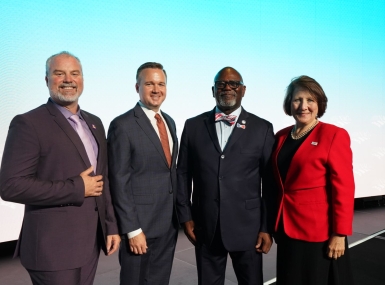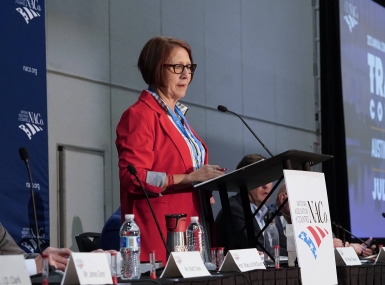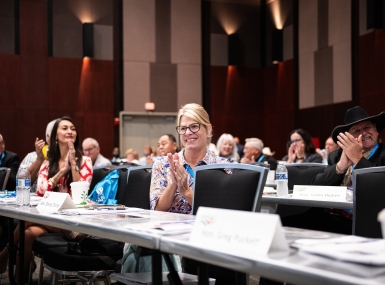Executive Committee
Resources
About
Overview of the Roles and Responsibilities of the NACo Executive Committee
Overview of roles and responsibilities for the NACo Executive Committee and specific duties of National Officers and Regional Representatives as outlined in the association's Bylaws.
- Consists of four National Officers and four Regional Representatives
- Executive oversight of the association as delegated by the Board of Directors
- Recommends the appointment of the CEO to the Board of Directors
- Completes an annual performance and compensation review for the CEO
- Four National Officers elected by the full membership at the annual business meeting
- Officers are President, First Vice President, Second Vice President, and Immediate Past President
- Responsible for the property, funds and business affairs in the absence of the Board
- Exercise all powers and authority granted by the Board
- Reports at each Board meeting with respect to the general state of the association, significant changes in the financial condition, and actions taken in the interim
- Prepares and recommends to the Board an annual budget for each fiscal year
Provides regional input to the President and other Officers, maintains close contact with counties within their regions, keeps members informed of association activities, and assists in membership recruitment and retention within their regions
2024-2025 Officers

Hon. James Gore

Hon. J.D. Clark

Hon. George Dunlap

Hon. Mary Jo McGuire
Regional Representatives

Hon. Ron Berry

Hon. Joe Briggs

Hon. Kurt Gibbs

Hon. Tammy Tincher
President
As outlined in the Bylaws, the role of the President includes:
- Be the chief elected official
- Preside at all meetings of the board, executive committee, and the annual business meeting
- Supervise all business of the association with the Executive Director
- Appoint members of all committees except those positions designated by these Bylaws
- Consult with the other officers on all appointments
- Assign to other officers’ specific areas of responsibility as needed
In practice, the duties of the president have included:
- Act as the primary spokesperson for the association, articulating the organization’s goals, positions, and policies to the public, media, and other external parties
- Represent the association as the primary ambassador at events organized by state associations, affiliates, and other partner entities, fostering relationships and promoting the interests of counties
- Delegate responsibilities among Officers and Regional Representatives for participation at events held by state associations, affiliates, and partners, ensuring a presence that aligns with the association's objectives
- Assign officers and regional representatives as executive committee liaisons to NACo committees, abiding by the Bylaws or board policies that govern these designations, to facilitate seamless communication and policy implementation
- Appoint the leadership of policy steering committees, determine the membership of non-policy committees, and select representatives for external stakeholder committees.
First Vice President
As outlined in the Bylaws, the role of the first vice president includes:
- Shall serve as the chair of the finance committee, overseeing the financial affairs of the association. This includes the development and implementation of financial policies, the review and approval of budgets, and the maintenance of comprehensive and accurate financial records
In practice, the duties of the first vice president have included:
- Serve as a member of NACo EDGE advisory board
- Undertake additional responsibilities as delegated by the NACo President.
Second Vice President
In practice, the duties of the second vice president have included:
- Serve as the Executive Committee Liaison to the Audit Committee
- Undertake additional responsibilities as delegated by the NACo President.
Immediate Past President
In practice, the duties of the immediate past president have included:
- Serve as the Executive Committee Liaison to the Defined Contribution and Retirement Advisory Committee (DCR), responsible primarily for oversight of the NACo-Nationwide Deferred Compensation Program.
- Undertake additional responsibilities as delegated by the NACo President.
Regional Representatives
As outlined in the Bylaws, the role of the Regional Representatives includes:
- Shall provide input to the President and the other Officers on behalf of their regions, provide close contact with counties within their regions, keep members informed of association activities, and assist in membership recruitment and retention in the regions
In practice, the duties of the Regional Representatives have included:
- Offer guidance and input to the Officers on regional matters, ensuring that the unique needs and perspectives of member counties within the region are considered in the association's decision-making processes
- Keep members within the region informed of NACo initiatives, policies, and opportunities, acting as a conduit for information and as an advocate for the association's mission and goals
- Assist with membership outreach efforts to bolster engagement, encourage retention, and recruit new members, thereby enhancing the association's regional and national impact
- Host monthly virtual meetings for the region, creating a platform for discussion, knowledge exchange, and collaborative action among county members. These calls are paused during the months when the Legislative Conference and the Annual Conference and Exposition take place, at which time the Regional Representative lead in person regional caucus meetings
Illinois, Indiana, Iowa, Kansas, Michigan, Minnesota, Missouri, Nebraska, Ohio, Oklahoma and Wisconsin
Delaware, District of Columbia, Maine, Maryland, Massachusetts, New Hampshire, New Jersey, New York, Pennsylvania and West Virginia. (Note: Vermont, Connecticut and Rhode Island would also be a part of the Northeast Region, but do not have NACo members.)
Alabama, Arkansas, Florida, Georgia, Kentucky, Louisiana, Mississippi, North Carolina, South Carolina, Tennessee, Texas and Virginia
Alaska, Arizona, California, Colorado, Hawaii, Idaho, Montana, Nevada, New Mexico, North Dakota, Oregon, South Dakota, Utah, Washington, and Wyoming





